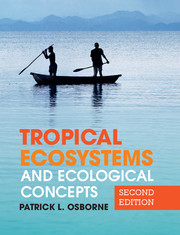Book contents
- Frontmatter
- Contents
- Preface
- Abbreviations and units
- Chapter 1 The tropical environment and climate
- Chapter 2 Dry, hot deserts and environmental factors
- Chapter 3 Grasslands and primary production
- Chapter 4 Savanna and population dynamics
- Chapter 5 Lakes, energy flow and biogeochemical cycling
- Chapter 6 Rivers, floodplains and estuaries
- Chapter 7 Wetlands and succession
- Chapter 8 Tropical rain forests and biodiversity
- Chapter 9 Mountains, zonation and community gradients
- Chapter 10 Mangroves, seagrasses and decomposition
- Chapter 11 Coral reefs and community ecology
- Chapter 12 Islands, archipelagos, biogeography and evolutionary ecology
- Chapter 13 Cities and human ecology
- Glossary
- References
- Index
- References
Chapter 3 - Grasslands and primary production
Published online by Cambridge University Press: 05 June 2012
- Frontmatter
- Contents
- Preface
- Abbreviations and units
- Chapter 1 The tropical environment and climate
- Chapter 2 Dry, hot deserts and environmental factors
- Chapter 3 Grasslands and primary production
- Chapter 4 Savanna and population dynamics
- Chapter 5 Lakes, energy flow and biogeochemical cycling
- Chapter 6 Rivers, floodplains and estuaries
- Chapter 7 Wetlands and succession
- Chapter 8 Tropical rain forests and biodiversity
- Chapter 9 Mountains, zonation and community gradients
- Chapter 10 Mangroves, seagrasses and decomposition
- Chapter 11 Coral reefs and community ecology
- Chapter 12 Islands, archipelagos, biogeography and evolutionary ecology
- Chapter 13 Cities and human ecology
- Glossary
- References
- Index
- References
Summary
Tropical grasslands, excluding wetlands, cover 15 million km2 and may be defined as ecosystems within the tropics in which graminaceous (grass-like) species dominate the vegetation. Thus, by this definition, tropical grasslands include not only purely herbaceous communities, but also the mixed grass and tree communities called savanna that we will discuss in chapter 4.
Grass-dominated communities occur naturally where soil moisture becomes insufficient to support a closed forest canopy, but is adequate for the development of, at least, patchy grass cover. The environmental factors that determine the transition from forest to grassland include precipitation, humidity, soil type, fire frequency and grazing pressure (Figure 3.1). Distinguishing between the wetter desert areas, grasslands and sparsely treed, open savannas is difficult and really of little ecological significance. There is a great deal of overlap in both appearance and function of the biotic components that exist in these three systems.
Temperate grasslands (prairies in North America, steppes in Eurasia and pampas in South America) generally lack woody vegetation and occur in regions with warm summers and cold winters. Tall grasses in wetter areas are replaced by shorter grasslands in areas subject to summer drought. Perennial grasses dominate both temperate and tropical grasslands, but in the drier areas of tropical grasslands annual species become increasingly important. Large areas of both temperate and tropical grasslands have been modified for livestock and crop production.
- Type
- Chapter
- Information
- Tropical Ecosystems and Ecological Concepts , pp. 59 - 80Publisher: Cambridge University PressPrint publication year: 2012



